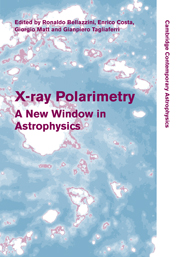Book contents
- Frontmatter
- Contents
- List of contributors
- Preface
- 1 X-ray polarimetry: historical remarks and other considerations
- Part I Polarimetry techniques
- Part II Polarized emission in X-ray sources
- Part III Future missions
- 37 Gravity and Extreme Magnetism SMEX (GEMS)
- 38 Programs of X-ray polarimetry in Italy
- 39 A polarimeter for IXO
- 40 Polarimetry with ASTRO-H soft gamma-ray detector
- 41 The Energetic X-ray Imaging Survey Telescope and its polarization sensitivity
- 42 PoGOLite: a balloon-borne soft gamma-ray polarimeter
- 43 Studies of neutron background rejection in the PoGOLite polarimeter
- 44 Observing polarized X-rays with PoGOLite
- 45 Pre-flight qualification tests of the PoGOLite detector system
- 46 The Gamma-RAy Polarimeter Experiment (GRAPE) balloon payload
- 47 POLAR: an instrument dedicated to GRB polarization measurement
- 48 Polarization detection capability of GRIPS
- 49 X-ray and γ-ray polarimetry small-satellite mission PolariS
- 50 GAP aboard the solar-powered sail mission
- 51 Hard X-ray polarimeter for small-satellite missions
- 52 Performance of hard X-ray polarimeter: PHENEX
- 53 GRB polarimetry with POET
- Author index
- Subject index
48 - Polarization detection capability of GRIPS
from Part III - Future missions
Published online by Cambridge University Press: 06 July 2010
- Frontmatter
- Contents
- List of contributors
- Preface
- 1 X-ray polarimetry: historical remarks and other considerations
- Part I Polarimetry techniques
- Part II Polarized emission in X-ray sources
- Part III Future missions
- 37 Gravity and Extreme Magnetism SMEX (GEMS)
- 38 Programs of X-ray polarimetry in Italy
- 39 A polarimeter for IXO
- 40 Polarimetry with ASTRO-H soft gamma-ray detector
- 41 The Energetic X-ray Imaging Survey Telescope and its polarization sensitivity
- 42 PoGOLite: a balloon-borne soft gamma-ray polarimeter
- 43 Studies of neutron background rejection in the PoGOLite polarimeter
- 44 Observing polarized X-rays with PoGOLite
- 45 Pre-flight qualification tests of the PoGOLite detector system
- 46 The Gamma-RAy Polarimeter Experiment (GRAPE) balloon payload
- 47 POLAR: an instrument dedicated to GRB polarization measurement
- 48 Polarization detection capability of GRIPS
- 49 X-ray and γ-ray polarimetry small-satellite mission PolariS
- 50 GAP aboard the solar-powered sail mission
- 51 Hard X-ray polarimeter for small-satellite missions
- 52 Performance of hard X-ray polarimeter: PHENEX
- 53 GRB polarimetry with POET
- Author index
- Subject index
Summary
We present the polarization capabilities of GRIPS (see www.gripsmission.eu), a proposed next-generation Compton-scattering and paircreation telescope.
Introduction
GRIPS, Gamma-Ray Burst Investigation via Polarimetry and Spectroscopy, had been proposed in 2007 in response to the ESA Cosmic Vision call as a new-generation Compton-and-pair telescope. Though it was not selected for further study, a variety of investigations are being performed to improve the concept and to verify the performance.
With the Compton scattering being dependent on the polarization of the incoming photons, any Compton telescope is, per se, a decent polarimeter. Beyond this, such detectors can be tailored to have a particularly high polarization sensitivity by obeying some simple design principles.
Polarization is the last property of high-energy electromagnetic radiation which has not been utilized to its full extent, and promises to uniquely determine the emission processes of a variety of astrophysical sources, among them pulsars, anomalous X-ray pulsars (AXP) and soft-gamma repeaters (SGR), or gamma-ray bursts (GRB).
GRIPS would carry two major telescopes: the gamma-ray monitor (GRM) and the X-ray monitor. The GRM is a combined Compton-scattering and pair-creation telescope for the energy range 0.2–50 MeV. It will thus follow the successful concepts of imaging high-energy photons used in COMPTEL (0.7–30 MeV) as well as EGRET (>30 MeV) and Fermi (>100 MeV) but combines them into one instrument. The following deals exclusively with the GRM concept, and its capability to measure polarization at unprecedented sensitivity.
- Type
- Chapter
- Information
- X-ray PolarimetryA New Window in Astrophysics, pp. 327 - 332Publisher: Cambridge University PressPrint publication year: 2010



